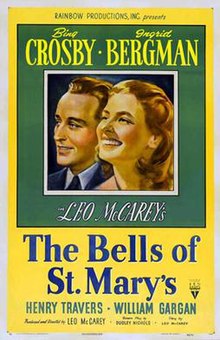The song was revived in 1945, in the film of the same name, by Bing Crosby and Ingrid Bergman.
| The Bells of St. Mary’s | |
|---|---|

Theatrical release poster
|
|
| Directed by | Leo McCarey |
| Produced by | Leo McCarey |
| Screenplay by | Dudley Nichols |
| Story by | Leo McCarey |
| Starring | |
| Music by | Robert Emmett Dolan |
| Cinematography | George Barnes |
| Edited by | Harry Marker |
|
Production company
|
|
| Distributed by | RKO Radio Pictures |
|
Release date
|
|
|
Running time
|
126 minutes |
| Country | United States |
| Language | English |
| Budget | $1.3 million |
| Box office | $21,333,333 (United States) |
The Bells of St. Mary’s is a 1945 American drama film produced and directed by Leo McCarey and starring Bing Crosby and Ingrid Bergman. Written by Dudley Nichols based on a story by Leo McCarey, the film is about a priest and a nun who, despite their good-natured rivalry, try to save their school from being shut down. The character of Father O’Malley had been previously portrayed by Crosby in the 1944 film Going My Way, for which Crosby had won the Academy Award for Best Actor. The film was produced by Leo McCarey’s production company, Rainbow Productions. The Bells of St. Mary’s has come to be commonly associated with the Christmas season, due most likely to the inclusion of a scene involving a Christmas pageant at the school, a major plot point involving an unlikely (yet prayed for) gift, and the fact that the film was released in December 1945. A reference to it is made in the 1946 film It’s a Wonderful Life, in which Henry Travers, a co-star of The Bells of St. Mary’s, played the guardian angel.
Plot
The unconventional Father Charles “Chuck” O’Malley (Bing Crosby) is assigned to St. Mary’s parish, which includes a run-down inner-city school building on the verge of being condemned. O’Malley is to recommend whether or not the school should be closed and the children sent to another school with modern facilities; but the sisters feel that God will provide for them. They put their hopes in Horace P. Bogardus (Henry Travers), a businessman who has built a modern building next door to the school which they hope he will donate to them. Father O’Malley and the dedicated but stubborn Sister Superior, Mary Benedict (Ingrid Bergman), both wish to save the school, but their different views and methods often lead to disagreements. One disagreement involves a student (Richard Tyler) who is being bullied by another. A more serious one regards the promotion of an eighth-grade student, Patsy (Joan Carroll), whom the parish has taken in while her mother (Martha Sleeper) attempts to get back on her feet. At one point, Sister Benedict contracts tuberculosis, and the physician recommends to Father O’Malley that she be transferred to a dry climate with non-parochial duties, but without telling her the reason. She assumes the transfer is because of her disagreements with O’Malley, and struggles to understand the reasons for the path set out for her. Right before Sister Benedict departs, Father O’Malley reveals the true reason for her temporary transfer.
Awards
The film won the Academy Award for Best Sound, Recording (Stephen Dunn), and was nominated for Best Actor in a Leading Role (Bing Crosby), Best Actress in a Leading Role (Ingrid Bergman), Best Director, Best Film Editing, Best Music, Scoring of a Dramatic or Comedy Picture, Best Music, Song (for Jimmy Van Heusen(music) and Johnny Burke (lyrics) for “Aren’t You Glad You’re You”) and Best Picture.
Bing Crosby’s Academy Award nomination for his portrayal of Father Chuck O’Malley made him the first actor in history to receive two nominations for portraying the same character.



































































Comments